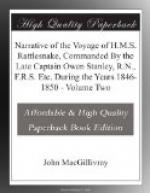In the evening we were joined by the Tam O’Shanter, a barque having on board a colonial overland expedition under Mr. Kennedy, which we are to accompany to Rockingham Bay, 1200 miles north from Sydney, where we are to assist in the disembarkation and starting of the party.
For the first nine days we averaged only thirty miles a day, owing to a long continuance of calms and light winds with a strong adverse current, which on one occasion set us to East-South-East fifty-three miles in twenty-four hours. At length, on May 8th we picked up a strong southerly breeze, accompanied by a northerly set. On May 12th we rounded Breaksea Spit, and Captain Stanley finding his original intention of passing inside of Lady Elliot’s Island impracticable, or at least involving unnecessary delay, determined to bear up North-West by West keeping outside of the Bunker and Capricorn Groups, and try the channel previously passed through by Captain F.P. Blackwood in H.M.S. Fly. Captain Stanley’s remarks on this subject are so important, that I give them verbatim:
ENTRANCE TO THE INNER PASSAGE.
“After reaching Lady Elliot’s Island, we steered a course direct for the High Peak of the Northumberland Islands, so as to pass between Bunker’s Group and Swain’s Reef, which affords a far better entrance into the Inner Passage, than the old route round Breaksea Spit inside the Bunker Group; when the course requires to be changed, and the channel is much narrower. We sounded every half hour without finding bottom, with from 80 to 120 fathoms, till we came to the soundings laid down by the Fly, which we found to agree almost exactly with ours.
“Our soundings were obtained by using Massey’s patent lead, with which we found we could reach the bottom at twenty-six fathoms, when the ship was going 9.2 knots an hour; and with such a guide any error in the reckoning would be detected, even by night, as the Bunker Group gives warning by the soundings. For a steamer going to Sydney by the Inner Route, this channel would be invaluable as far as the Pine Peak of the Percy Isles. One direct course will lead out to sea clear of all the reefs, a distance of more than 200 miles, during which period there would be ample time to ascertain by observations of the sun, whether any current had been experienced sufficient to place the ship in danger, and, as the channel between Swain’s Reef and the Bunker Group appears to be clear, there is a drift of thirty miles on each side the course from the High Peak.”
May 15th.
After having at daylight sighted the land about Port Bowen and Cape Townshend, we passed the Northumberland and Percy Isles to the westward, the water being very smooth with light airs from South to East-North-East. A very offensive smell which has been experienced in the after part of the ship for a week back, was today traced to some preserved meats prepared in Sydney; 1036 pounds of these being found quite putrid were condemned.*




